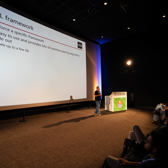Mastering Infrastructure as Code
UAIC
3 days
Interested in a private company training? Request it here.
Not ready to book yet? Request an offer here.
Introduction to GitOps
GitOps is a way of implementing continuous deployment for cloud native applications. It focuses on a developer-centric experience when operating infrastructure, by using tools developers are already familiar with, including Git and Continuous Deployment tools.
- What is GitOps?
- Why should you use GitOps?
- How does GitOps work?
- GitOps Services and Tooling: Git(Hub), Azure DevOps, Kubernetes, Terraform, Flux, ...
Azure Resource Manager Templates
To implement infrastructure as code for your Azure resources, ARM templates can be used. The template is a JSON file that defines the infrastructure and configuration for your project using a declarative syntax.
- Infrastructure as Code
- Authoring ARM Templates
- Parameters, Variables, Resources, Output
- Nested Templates
- Validating ARM Templates: Test Toolkit, Pester
- LAB: Deploy Azure Resources with ARM Templates
Terraform
Terraform is an open-source infrastructure as code tool that allows you to manage many different cloud services. It uses a simplified syntax which allows for concise descriptions of your resources.
- Terraform Features
- Configuration and Providers
- Variables, Resources, Secrets
- Terraform State
- LAB: Deploy Azure Resources with Terraform
The Bicep Language
Bicep is a transparent abstraction over ARM templates that significantly reduces the complexity of your templates. During deployment, the Bicep CLI converts a Bicep file into an ARM template.
- Benefits of Bicep Versus Other Tools
- Install Bicep Tools
- Author Resources
- Parameters, Variables, Outputs
- Validate Files with Bicep Linter
- Migrate from ARM Templates to Bicep
- LAB: Deploy Azure Resources with Bicep
Desired State Configuration (DSC)
Automate the configuration of your VMs.
- Benefits of Desired State Configuration
- DSC Components: Configuration, Resources, Compilation
- Enact Your Configuration: Push or Pull mode
- Enact Your Configuration with Azure Machine Configuration
- LAB: Configure a Virtual Machine with PowerShell DSC
Using Git
Sources are probably the most important part in any software project and we need a way to keep track of all sources and their changes. You can use Git to store all the assets, such as templates (ARM, Terraform, ...), needed to deploy your infrastructure.
- Version Control Concepts
- Distributed Source Control with Git
- Creating a Local Repository
- Cloning a Remote Repository
- Staging Files
- Committing Files
- Branching Strategies
- Using Forks
- Merge vs. Rebase
- Synchronizing with a Remote Repository
- Pull Requests
- LAB: Working with Git
Continuous Integration
To build quality software, and to limit nasty integration problems at the end of the project, doing a daily integration build is long regarded as a best practice.
- GitHub Actions and Azure DevOps Pipelines
- Continuous Integration
- Understanding GitHub Workflows and DevOps Pipelines
- Triggers, Jobs and Steps
- Using Variables
- Defining and Using Secrets
- LAB: Setting up a Build Definition to Build and Test Your Deployment Target
- LAB: Using CI to Deploy a SQL Server Database Using ARM templates
Continuous Deployment
With continuous deployment you can automatically setup your environment in a consistent state, whenever you want. Not only can you deploy your application, but you can also setup all the required infrastructure components.
- Release Management and Continuous Deployment
- Deploying Artifacts
- Integrating with Azure Using Service Principals or Managed Identities
- Using Environments During Deployment
- LAB: Deploying a Website to an Azure WebApp
- LAB: Deploying a Virtual Machine using Terraform
- LAB: CI/CD Using Bicep to Manage Infrastructure in Azure
GitHub Workflow Runners and Azure DevOps Agents
GitHub Actions and Azure DevOps pipelines require a platform to build and deploy application code and infrastructure components, known as agents/runners.
- DevOps Agents and GitHub Runners
- Using DevOps Hosted Agents and GitHub Hosted Runners
- Setting up a Windows Hosted Runner
In the past, managing an IT infrastructure was a hard job. System administrators had to manually manage and configure all of the hardware and software that was needed for the applications to run.
However, in recent years, trends like "Infrastructure as Code" improved the way organizations design, develop, and maintain their IT infrastructure dramatically. The core idea of "Infrastructure as Code" is having a declarative description of the desired infrastructure and an automated process to make the production environment match the described state. In this course, you will learn about the tools that will help you setup this kind of deployment for your Azure infrastructure. To perform the labs, students can choose between GitHub and Azure DevOps since these technologies are almost identical.
IT Pros who are interested in learning how to deploy their cloud infrastructure in an easy, fully automated way.








